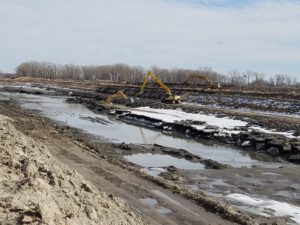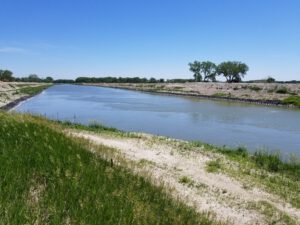The Farwell and Sargent Irrigation Districts of central Nebraska were constructed by the Bureau of Reclamation in the 1950s and early 1960s under the umbrella of the Loup Basin Reclamation District. Loup Basin owns the easements, the water rights, and the facilities, while the other two irrigation districts operate and maintain those facilities. In 2002, Loup Basin had the title for its system transferred to it from the federal government.
Matt Lukasiewicz is the general manager of the Loup Basin Reclamation District, the Farwell Irrigation District, and the Sargent Irrigation District. In this interview, he speaks with Irrigation Leader Editor-in-Chief Kris Polly about his districts’ infrastructure projects and financing strategies 17 years after title transfer.

Kris Polly: Please tell us about your irrigation districts.
Matt Lukasiewicz: As far as size, Farwell has about 53,755 irrigated acres. In a normal year, we will deliver
our irrigators an average of 9 inches of water. The total amount of water we actually divert into Sherman Reservoir varies depending on climate, but on average we take about 107,000 acre-feet per year. At Sargent, we have about 14,626 irrigated acres and deliver an average of 10 inches of water annually. The primary crops are corn and soybeans.
Kris Polly: What is the primary method of irrigation?
Matt Lukasiewicz: Sargent, which is a smaller district, lays a lot flatter than Farwell. It is about 70 percent pivot irrigated. Farwell is hillier, or there’s at least more slope, so gravity irrigation is more common. Pivots are still working their way in; currently, I think it is about 40 percent pivot irrigated. The rest is gravity.
Kris Polly: When was the title of the project transferred to you?
Matt Lukasiewicz: The official date was in November 2002.Kris Polly: How does the district obtain financing for capital improvements?

Matt Lukasiewicz: First and foremost, we try to budget for them. We prioritize projects that will benefit our water users. Occasionally, engineering is required, so we try to plan a year in advance and apply for grant funding. We always keep the worst-case scenario in mind and budget for 100 percent of the cost of the project. Every year, we put $150,000 into a project improvement reserve fund. Then, every 3 years, we put a lateral or canal system into the ground with PVC pipe. Generally, the $450,000 that accumulates in that fund after 3 years is enough to cover most of the materials for a pipeline. At this point in our pipe burial program, we’re getting to the end of being able to bury many more canals and laterals just because of the size of the laterals and the fact that some of those areas lay too flat. Those factors mean that larger pipe is needed, which is costlier and affects the feasibility of a project. We’re looking at some potential projects for the future aside from pipe, so we will continue to add $150,000 to that project improvement reserve every year.
Kris Polly: How many employees do you have?
Matt Lukasiewicz is the general manager of the Loup Basin Reclamation District, the Farwell Irrigation District, and the Sargent Irrigation District. He can be contacted at mluk@qwestoffice.net or (308) 336-3341.
